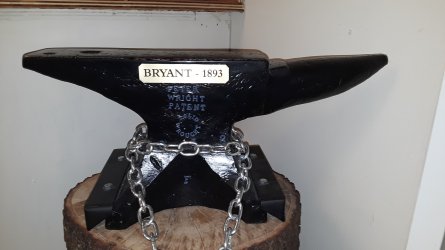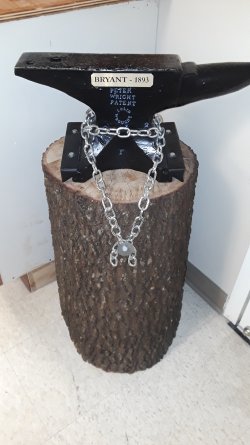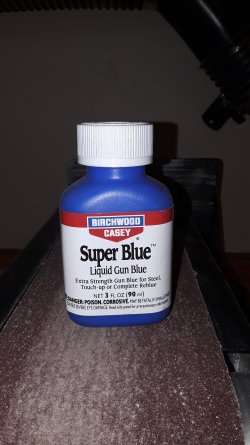jumpinjoe
Hellcat
OK, was able to hobble down to the shop today fro a couple quick pics. This is the 'cold blue" I used and even though it doesn't show up in the attachment, in real life under just the right light it shows a very suttle dark blue undertone under the black from the rust convertor. I simply wiped it on with a micro fiber cloth after a real good cleaning with acetone. Make sure any acetone is absolutely dry before applying the cold blue, but don't wait long enough for any visible surface rust to form.
As for the anvil itself, I very carefully used a right angle grinder to take off only where there was any metal rolled over on itself from years of hammering to ensure there was no rust growing underneath it. Too much grinding on the surface of an antique anvil will decrease it's value much like doing the wrong thing to an old firearm.
After a good going over with the grinder, I spent probably 20+ hours with a hand-held Dremel using miniature grinding wheels, rotary tools and mini wire brushes to clean rust from any/all tiny nicks, gouges, and hammer marks over the whole thing. Then a complete rub down with a good buffing compound followed by a soap/water wash down and a good blow dry with a hot air gun.
Then the acetone wash followed by the cold blue solution. I was afraid it would leave streaks but it flowed on as smooth as you could ask for and dried to a flawless finish.....very dark blue (almost black) but almost translucent. I used a pale blue finger nail polish thinned with acetone to paint/highlight the cast lettering showing the manufacturer's (Peter Wright) foundry, patent approval and weight characters.
The weight can be read from the three numbers across the waist just visible under the chain. The first number is in English Hundredweight (1 HW = 112 lbs) so a 'zero' indicates it weighs less than 112 lbs, a 1 would indicate it weighs at least 112 lbs. A 2 would mean 224 lbs, etc. So then we move to the second number which is a 3. That number is a multiple of 25% of a HW, or 28 lbs, so a 3 would indicate 3*28=84 lbs. To that number then we add the total of the third number or 3 which give us a total weight of 0+84+3=87 lbs. And I can promise you it weighed every pound of that every time I had to lift it to move it or turn it while working on it.
BTW, the patent date for that particular anvil was 1852 and that particular patent marking was used up until either 1860 or 1885 one or the other ..... couldn't nail it down exactly. But the anvil came into the Bryant family's hands in 1893. So, from all that we can deduce it is at the very least 136 yrs old, probably more like 150-170 yrs old. At any rate the family has owned it for about 128 yrs and it is a very prized family possession. Mr. Bryant was a little hesitant to let me do anything to it, but based on some examples of some of my work he had seen, he agreed to it. And in the final analysis he loved it. And according to our info we did nothing to hamper the real collectors value of it. That would be somewhere in the neighborhood of between $6-$8 lb restored correctly. Around $650-$700 to the first collector, probably more at auction.
Anyway, that's about it for today. Hope identifying the cold blue product helps you.


I enjoyed very much doing the restoration for the family, it was a lot of fun and even educational.
As an aside, any of you who might run across a reasonably good anvil out in somebody's weed patch or flower garden and they'd like to sell it, please let me know along with some contact info. That's where you'll find probably 80%-90% of them all these days just rusting away. I'd be interesting in buying some of them at a reasonable cost just to do the restoration on them for a collection of my own.
As for the anvil itself, I very carefully used a right angle grinder to take off only where there was any metal rolled over on itself from years of hammering to ensure there was no rust growing underneath it. Too much grinding on the surface of an antique anvil will decrease it's value much like doing the wrong thing to an old firearm.
After a good going over with the grinder, I spent probably 20+ hours with a hand-held Dremel using miniature grinding wheels, rotary tools and mini wire brushes to clean rust from any/all tiny nicks, gouges, and hammer marks over the whole thing. Then a complete rub down with a good buffing compound followed by a soap/water wash down and a good blow dry with a hot air gun.
Then the acetone wash followed by the cold blue solution. I was afraid it would leave streaks but it flowed on as smooth as you could ask for and dried to a flawless finish.....very dark blue (almost black) but almost translucent. I used a pale blue finger nail polish thinned with acetone to paint/highlight the cast lettering showing the manufacturer's (Peter Wright) foundry, patent approval and weight characters.
The weight can be read from the three numbers across the waist just visible under the chain. The first number is in English Hundredweight (1 HW = 112 lbs) so a 'zero' indicates it weighs less than 112 lbs, a 1 would indicate it weighs at least 112 lbs. A 2 would mean 224 lbs, etc. So then we move to the second number which is a 3. That number is a multiple of 25% of a HW, or 28 lbs, so a 3 would indicate 3*28=84 lbs. To that number then we add the total of the third number or 3 which give us a total weight of 0+84+3=87 lbs. And I can promise you it weighed every pound of that every time I had to lift it to move it or turn it while working on it.
BTW, the patent date for that particular anvil was 1852 and that particular patent marking was used up until either 1860 or 1885 one or the other ..... couldn't nail it down exactly. But the anvil came into the Bryant family's hands in 1893. So, from all that we can deduce it is at the very least 136 yrs old, probably more like 150-170 yrs old. At any rate the family has owned it for about 128 yrs and it is a very prized family possession. Mr. Bryant was a little hesitant to let me do anything to it, but based on some examples of some of my work he had seen, he agreed to it. And in the final analysis he loved it. And according to our info we did nothing to hamper the real collectors value of it. That would be somewhere in the neighborhood of between $6-$8 lb restored correctly. Around $650-$700 to the first collector, probably more at auction.
Anyway, that's about it for today. Hope identifying the cold blue product helps you.



I enjoyed very much doing the restoration for the family, it was a lot of fun and even educational.
As an aside, any of you who might run across a reasonably good anvil out in somebody's weed patch or flower garden and they'd like to sell it, please let me know along with some contact info. That's where you'll find probably 80%-90% of them all these days just rusting away. I'd be interesting in buying some of them at a reasonable cost just to do the restoration on them for a collection of my own.
